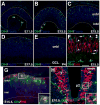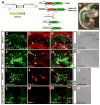Selective neuronal lineages derived from Dll4-expressing progenitors/precursors in the retina and spinal cord
- PMID: 25179941
- PMCID: PMC4276465
- DOI: 10.1002/dvdy.24185
Selective neuronal lineages derived from Dll4-expressing progenitors/precursors in the retina and spinal cord
Abstract
Background: During retinal and spinal cord neurogenesis, Notch signaling plays crucial roles in regulating proliferation and differentiation of progenitor cells. One of the Notch ligands, Delta-like 4 (Dll4), has been shown to be expressed in subsets of retinal and spinal cord progenitors/precursors and involved in neuronal subtype specification. However, it remains to be determined whether Dll4 expression has any progenitor/precursor-specificity contributing to its functional specificity during neural development.
Results: We generated a Dll4-Cre BAC transgenic mouse line that drives Cre recombinase expression mimicking that of the endogenous Dll4 in the developing retina and spinal cord. By fate-mapping analysis, we found that Dll4-expressing progenitors/precursors give rise to essentially all cone, amacrine and horizontal cells, a large portion of rod and ganglion cells, but only few bipolar and Müller cells. In the spinal cord, Dll4-expressing progenitors/precursors generate almost all V2a and V2c cells while producing only a fraction of the cells for other interneuron and motor neuron subtypes along the dorsoventral axis.
Conclusions: Our data suggest that selective expression of Dll4 in progenitors/precursors contributes to its functional specificity in neuronal specification and that the Dll4-Cre line is a valuable tool for gene manipulation to study Notch signaling.
Keywords: Dll4; Notch signaling; V2 interneuron; neuronal lineage; retina; spinal cord.
© 2014 Wiley Periodicals, Inc.
Figures








Similar articles
-
Asymmetric activation of Dll4-Notch signaling by Foxn4 and proneural factors activates BMP/TGFβ signaling to specify V2b interneurons in the spinal cord.Development. 2014 Jan;141(1):187-98. doi: 10.1242/dev.092536. Epub 2013 Nov 20. Development. 2014. PMID: 24257627 Free PMC article.
-
Forkhead box N4 (Foxn4) activates Dll4-Notch signaling to suppress photoreceptor cell fates of early retinal progenitors.Proc Natl Acad Sci U S A. 2012 Feb 28;109(9):E553-62. doi: 10.1073/pnas.1115767109. Epub 2012 Feb 8. Proc Natl Acad Sci U S A. 2012. PMID: 22323600 Free PMC article.
-
Dll1 and Dll4 function sequentially in the retina and pV2 domain of the spinal cord to regulate neurogenesis and create cell diversity.Dev Biol. 2009 Apr 1;328(1):54-65. doi: 10.1016/j.ydbio.2009.01.011. Epub 2009 Jan 14. Dev Biol. 2009. PMID: 19389377
-
Ventral neurogenesis and the neuron-glial switch.Neuron. 2001 Sep 13;31(5):677-80. doi: 10.1016/s0896-6273(01)00430-5. Neuron. 2001. PMID: 11567609 Review.
-
Specification of dorsal spinal cord interneurons.Curr Opin Neurobiol. 2003 Feb;13(1):42-9. doi: 10.1016/s0959-4388(03)00010-2. Curr Opin Neurobiol. 2003. PMID: 12593981 Review.
Cited by
-
Single-cell multiome sequencing clarifies enteric glial diversity and identifies an intraganglionic population poised for neurogenesis.Cell Rep. 2023 Mar 28;42(3):112194. doi: 10.1016/j.celrep.2023.112194. Epub 2023 Feb 28. Cell Rep. 2023. PMID: 36857184 Free PMC article.
-
The long noncoding RNA nHOTAIRM1 is necessary for differentiation and activity of iPSC-derived spinal motor neurons.Cell Death Dis. 2023 Nov 14;14(11):741. doi: 10.1038/s41419-023-06196-y. Cell Death Dis. 2023. PMID: 37963881 Free PMC article.
-
Regulation of retinal amacrine cell generation by miR-216b and Foxn3.Development. 2022 Jan 15;149(2):dev199484. doi: 10.1242/dev.199484. Epub 2022 Jan 17. Development. 2022. PMID: 34919141 Free PMC article.
-
Zika virus impairs the development of blood vessels in a mouse model of congenital infection.Sci Rep. 2018 Aug 24;8(1):12774. doi: 10.1038/s41598-018-31149-3. Sci Rep. 2018. PMID: 30143723 Free PMC article.
-
Molecular and cellular development of spinal cord locomotor circuitry.Front Mol Neurosci. 2015 Jun 16;8:25. doi: 10.3389/fnmol.2015.00025. eCollection 2015. Front Mol Neurosci. 2015. PMID: 26136656 Free PMC article. Review.
References
-
- Arber S, Han B, Mendelsohn M, Smith M, Jessell TM, Sockanathan S. Requirement for the homeobox gene Hb9 in the consolidation of motor neuron identity. Neuron. 1999;23:659–674. - PubMed
-
- Baas D, Bumsted KM, Martinez JA, Vaccarino FM, Wikler KC, Barnstable CJ. The subcellular localization of Otx2 is cell-type specific and developmentally regulated in the mouse retina. Brain Res Mol Brain Res. 2000;78:26–37. - PubMed
-
- Benedito R, Duarte A. Expression of Dll4 during mouse embryogenesis suggests multiple developmental roles. Gene Expr Patterns. 2005;5:750–755. - PubMed
-
- Billiard F, Kirshner JR, Tait M, Danave A, Taheri S, Zhang W, Waite JC, Olson K, Chen G, Coetzee S, Hylton D, Murphy AJ, Yancopoulos GD, Thurston G, Skokos D. Ongoing Dll4-Notch signaling is required for T-cell homeostasis in the adult thymus. Eur J Immunol. 2011;41:2207–2216. - PubMed
Publication types
MeSH terms
Substances
Grants and funding
LinkOut - more resources
Full Text Sources
Other Literature Sources
Medical
Molecular Biology Databases
Research Materials

